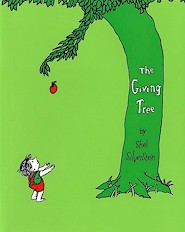 Classic.
This simple, moving children's book by Shel Silverstein has opened
up plenty of debates, both over its meaning and its appropriateness for
children! The story features a boy and an apple tree. When he is
young, the boy loves to eat the tree's apples, swing on the tree,
and sit at its side. He even carves a heart on the tree, with the
initials, "Me + T".
Classic.
This simple, moving children's book by Shel Silverstein has opened
up plenty of debates, both over its meaning and its appropriateness for
children! The story features a boy and an apple tree. When he is
young, the boy loves to eat the tree's apples, swing on the tree,
and sit at its side. He even carves a heart on the tree, with the
initials, "Me + T".
The years pass, and the boy grows into adolescence, carving a
new heart above the original one, with the initials of his
presumed girlfriend. More years pass, and the boy returns to the
tree. Although the tree offers him a swing and an apple to eat,
the boy (now a young man) claims he is more interested in making
money. The tree gracefully offers him her apples to sell in the
market. Later, the "boy" revisits her, and the tree,
quite eager to make him happy, offers him her branches to build a
home for his wife and children. Later, the boy returns (now in
midlife), claiming he needs a boat, and the tree offers her trunk!
Years later, the boy is now quite aged, and he returns to the
apple tree, now a mere stump. The tree cannot imagine that she has
anything left to offer the "boy", but since he is too
old to do much else, he uses the stump to rest--and the tree
"is happy".
The intent and meaning of this book has "stumped"
many over the years. Some find The Giving Tree to be a sad
tale of codependency--about a tree that doesn't stop giving, and a
boy who doesn't stop taking. I tend to think of the book as a
story about the unconditional love a parent gives a child--the
parent gives what he/she can, fully aware (and mostly happy) that
the child will grow to be independent of the parent. The boy/man
clearly develops a life of his own. This in itself is not sad.
However, that the tree is reduced to a stump is not exactly fun;
and, that the boy only appreciates the tree near the end of his
life is indeed sad! The story can be viewed as one that makes
people stop to think. A gentle lesson about appreciation can be
pulled from the story, and it's a lesson that is subtle enough
that, if picked up, can be all the more powerful simply because it
was never force-fed.
No matter how you look at it, the book is certainly a
conversation piece. Controversy aside, the illustrations are
simple line drawings that are effective enough that they could
easily tell the story without ever reading the text.
Written and illustrated by Shel Silverstein. The
book is available in a hardcover edition that retails for approximately
$15.99 US.
[For more information, user reviews, or to buy: